Barriers in Implementing Ergonomics in UK Organizations: A Study
VerifiedAdded on 2023/04/21
|45
|13260
|322
Report
AI Summary
This report examines the reasons behind the low adoption rate of ergonomics in UK workplaces. It identifies barriers such as the perception of ergonomics as merely an occupational health and safety issue, lack of knowledge, and unrealistic expectations for short-term results. The research uses a mixed-methods approach, including semi-structured interviews with employees from three different organizations, and thematic analysis to analyze the collected data. Findings indicate that organizations often fail to recognize the long-term benefits of ergonomics, including improved productivity, quality, and profitability. The report also highlights the importance of participatory ergonomics and provides recommendations for successful implementation strategies. The study emphasizes the need for a holistic approach that integrates ergonomics with workplace health and safety policies to improve overall worker well-being and organizational performance. Desklib provides access to this report and other study tools for students.

Running head: BARRIERS IN IMPLEMENTING ERGONOMICS IN ORGANISATIONS
Exploring Reason behind poor acceptance of Ergonomic Work Environment in Most of the
Organisations
Name of the Student
Name of the University
Author note
Exploring Reason behind poor acceptance of Ergonomic Work Environment in Most of the
Organisations
Name of the Student
Name of the University
Author note
Paraphrase This Document
Need a fresh take? Get an instant paraphrase of this document with our AI Paraphraser
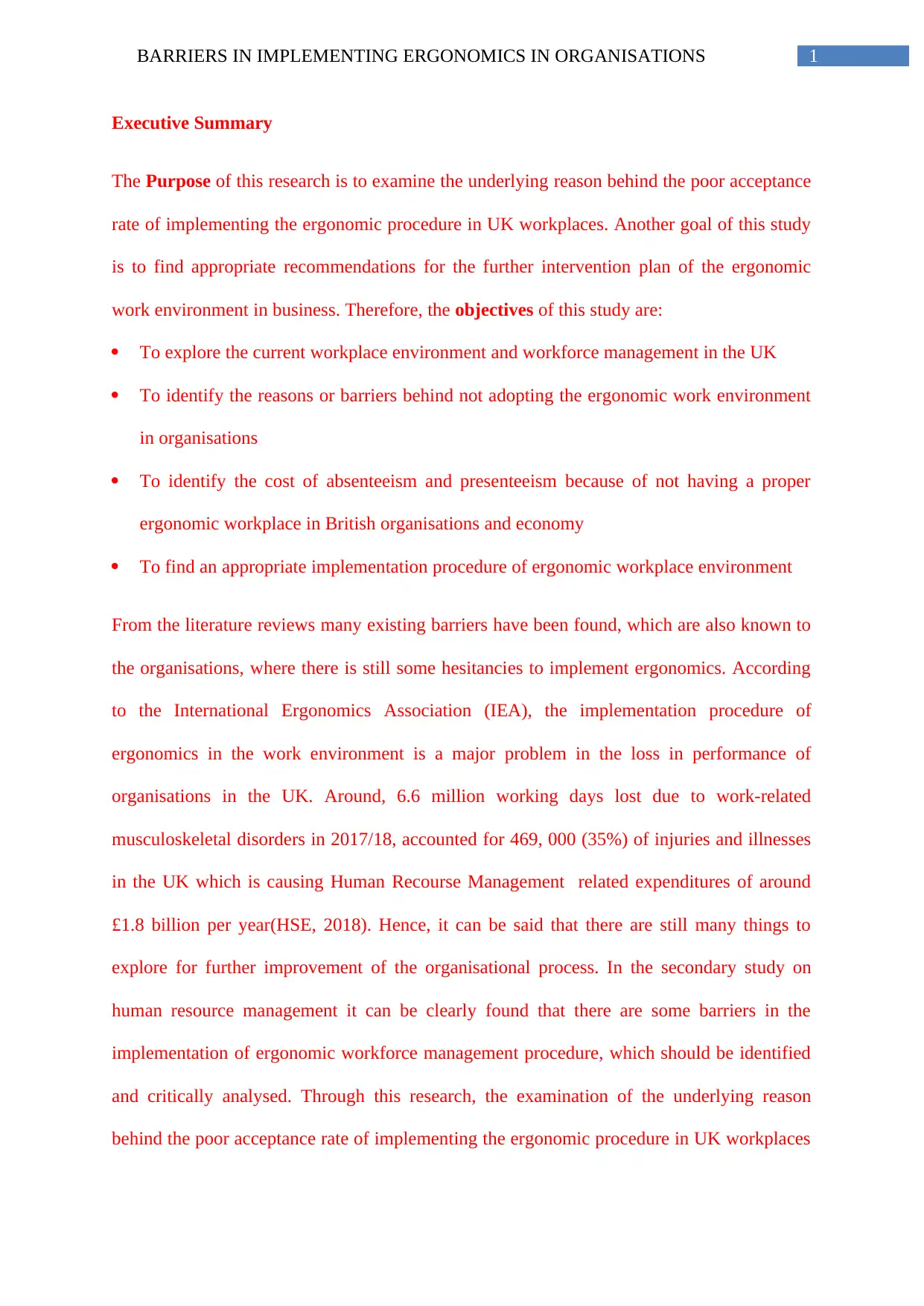
1BARRIERS IN IMPLEMENTING ERGONOMICS IN ORGANISATIONS
Executive Summary
The Purpose of this research is to examine the underlying reason behind the poor acceptance
rate of implementing the ergonomic procedure in UK workplaces. Another goal of this study
is to find appropriate recommendations for the further intervention plan of the ergonomic
work environment in business. Therefore, the objectives of this study are:
To explore the current workplace environment and workforce management in the UK
To identify the reasons or barriers behind not adopting the ergonomic work environment
in organisations
To identify the cost of absenteeism and presenteeism because of not having a proper
ergonomic workplace in British organisations and economy
To find an appropriate implementation procedure of ergonomic workplace environment
From the literature reviews many existing barriers have been found, which are also known to
the organisations, where there is still some hesitancies to implement ergonomics. According
to the International Ergonomics Association (IEA), the implementation procedure of
ergonomics in the work environment is a major problem in the loss in performance of
organisations in the UK. Around, 6.6 million working days lost due to work-related
musculoskeletal disorders in 2017/18, accounted for 469, 000 (35%) of injuries and illnesses
in the UK which is causing Human Recourse Management related expenditures of around
£1.8 billion per year(HSE, 2018). Hence, it can be said that there are still many things to
explore for further improvement of the organisational process. In the secondary study on
human resource management it can be clearly found that there are some barriers in the
implementation of ergonomic workforce management procedure, which should be identified
and critically analysed. Through this research, the examination of the underlying reason
behind the poor acceptance rate of implementing the ergonomic procedure in UK workplaces
Executive Summary
The Purpose of this research is to examine the underlying reason behind the poor acceptance
rate of implementing the ergonomic procedure in UK workplaces. Another goal of this study
is to find appropriate recommendations for the further intervention plan of the ergonomic
work environment in business. Therefore, the objectives of this study are:
To explore the current workplace environment and workforce management in the UK
To identify the reasons or barriers behind not adopting the ergonomic work environment
in organisations
To identify the cost of absenteeism and presenteeism because of not having a proper
ergonomic workplace in British organisations and economy
To find an appropriate implementation procedure of ergonomic workplace environment
From the literature reviews many existing barriers have been found, which are also known to
the organisations, where there is still some hesitancies to implement ergonomics. According
to the International Ergonomics Association (IEA), the implementation procedure of
ergonomics in the work environment is a major problem in the loss in performance of
organisations in the UK. Around, 6.6 million working days lost due to work-related
musculoskeletal disorders in 2017/18, accounted for 469, 000 (35%) of injuries and illnesses
in the UK which is causing Human Recourse Management related expenditures of around
£1.8 billion per year(HSE, 2018). Hence, it can be said that there are still many things to
explore for further improvement of the organisational process. In the secondary study on
human resource management it can be clearly found that there are some barriers in the
implementation of ergonomic workforce management procedure, which should be identified
and critically analysed. Through this research, the examination of the underlying reason
behind the poor acceptance rate of implementing the ergonomic procedure in UK workplaces
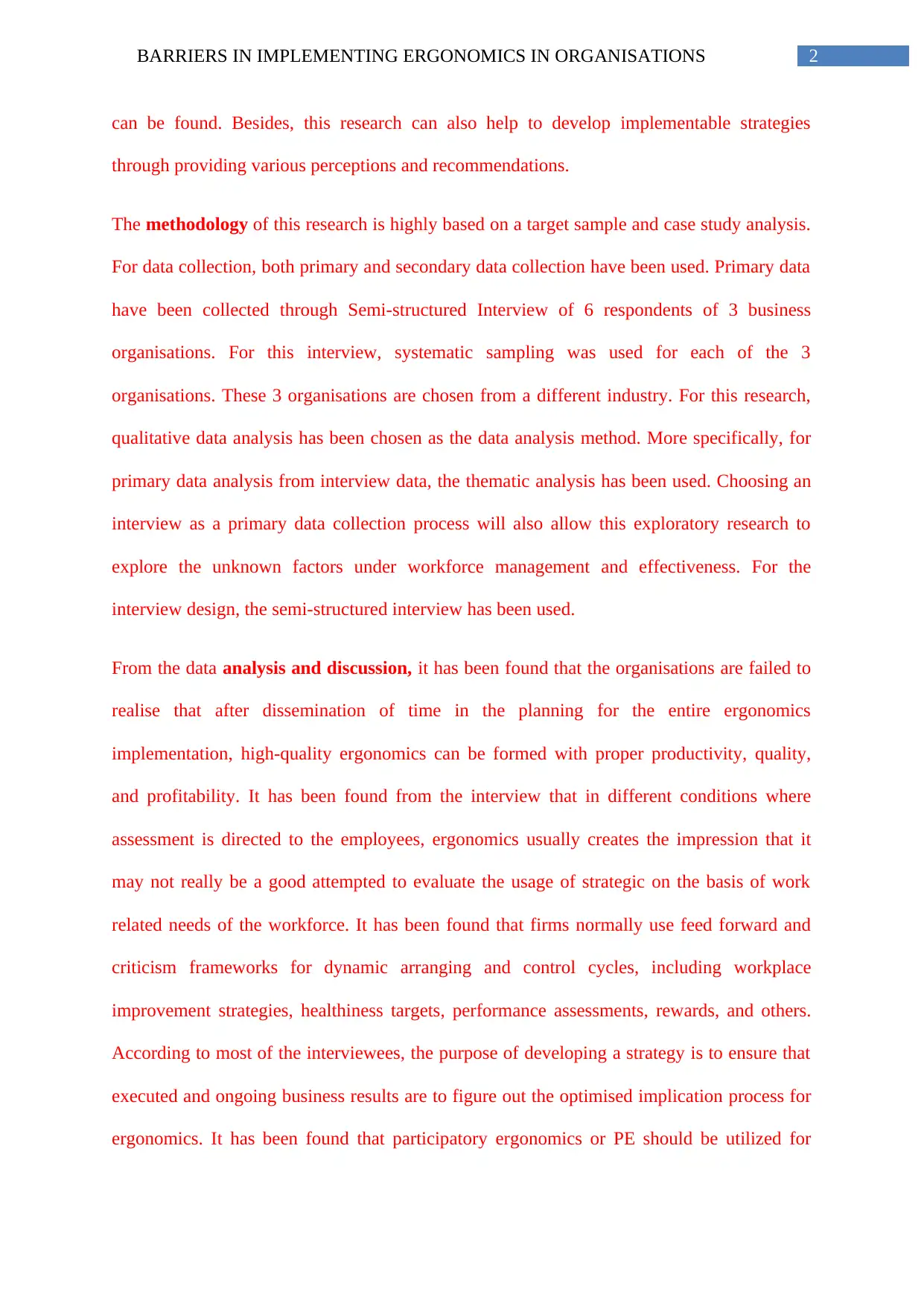
2BARRIERS IN IMPLEMENTING ERGONOMICS IN ORGANISATIONS
can be found. Besides, this research can also help to develop implementable strategies
through providing various perceptions and recommendations.
The methodology of this research is highly based on a target sample and case study analysis.
For data collection, both primary and secondary data collection have been used. Primary data
have been collected through Semi-structured Interview of 6 respondents of 3 business
organisations. For this interview, systematic sampling was used for each of the 3
organisations. These 3 organisations are chosen from a different industry. For this research,
qualitative data analysis has been chosen as the data analysis method. More specifically, for
primary data analysis from interview data, the thematic analysis has been used. Choosing an
interview as a primary data collection process will also allow this exploratory research to
explore the unknown factors under workforce management and effectiveness. For the
interview design, the semi-structured interview has been used.
From the data analysis and discussion, it has been found that the organisations are failed to
realise that after dissemination of time in the planning for the entire ergonomics
implementation, high-quality ergonomics can be formed with proper productivity, quality,
and profitability. It has been found from the interview that in different conditions where
assessment is directed to the employees, ergonomics usually creates the impression that it
may not really be a good attempted to evaluate the usage of strategic on the basis of work
related needs of the workforce. It has been found that firms normally use feed forward and
criticism frameworks for dynamic arranging and control cycles, including workplace
improvement strategies, healthiness targets, performance assessments, rewards, and others.
According to most of the interviewees, the purpose of developing a strategy is to ensure that
executed and ongoing business results are to figure out the optimised implication process for
ergonomics. It has been found that participatory ergonomics or PE should be utilized for
can be found. Besides, this research can also help to develop implementable strategies
through providing various perceptions and recommendations.
The methodology of this research is highly based on a target sample and case study analysis.
For data collection, both primary and secondary data collection have been used. Primary data
have been collected through Semi-structured Interview of 6 respondents of 3 business
organisations. For this interview, systematic sampling was used for each of the 3
organisations. These 3 organisations are chosen from a different industry. For this research,
qualitative data analysis has been chosen as the data analysis method. More specifically, for
primary data analysis from interview data, the thematic analysis has been used. Choosing an
interview as a primary data collection process will also allow this exploratory research to
explore the unknown factors under workforce management and effectiveness. For the
interview design, the semi-structured interview has been used.
From the data analysis and discussion, it has been found that the organisations are failed to
realise that after dissemination of time in the planning for the entire ergonomics
implementation, high-quality ergonomics can be formed with proper productivity, quality,
and profitability. It has been found from the interview that in different conditions where
assessment is directed to the employees, ergonomics usually creates the impression that it
may not really be a good attempted to evaluate the usage of strategic on the basis of work
related needs of the workforce. It has been found that firms normally use feed forward and
criticism frameworks for dynamic arranging and control cycles, including workplace
improvement strategies, healthiness targets, performance assessments, rewards, and others.
According to most of the interviewees, the purpose of developing a strategy is to ensure that
executed and ongoing business results are to figure out the optimised implication process for
ergonomics. It has been found that participatory ergonomics or PE should be utilized for
⊘ This is a preview!⊘
Do you want full access?
Subscribe today to unlock all pages.

Trusted by 1+ million students worldwide

3BARRIERS IN IMPLEMENTING ERGONOMICS IN ORGANISATIONS
advancement and usage of altered and potentially beneficial ergonomic measures, while
aiming at improved execution of officially arranged ergonomic measures.
advancement and usage of altered and potentially beneficial ergonomic measures, while
aiming at improved execution of officially arranged ergonomic measures.
Paraphrase This Document
Need a fresh take? Get an instant paraphrase of this document with our AI Paraphraser
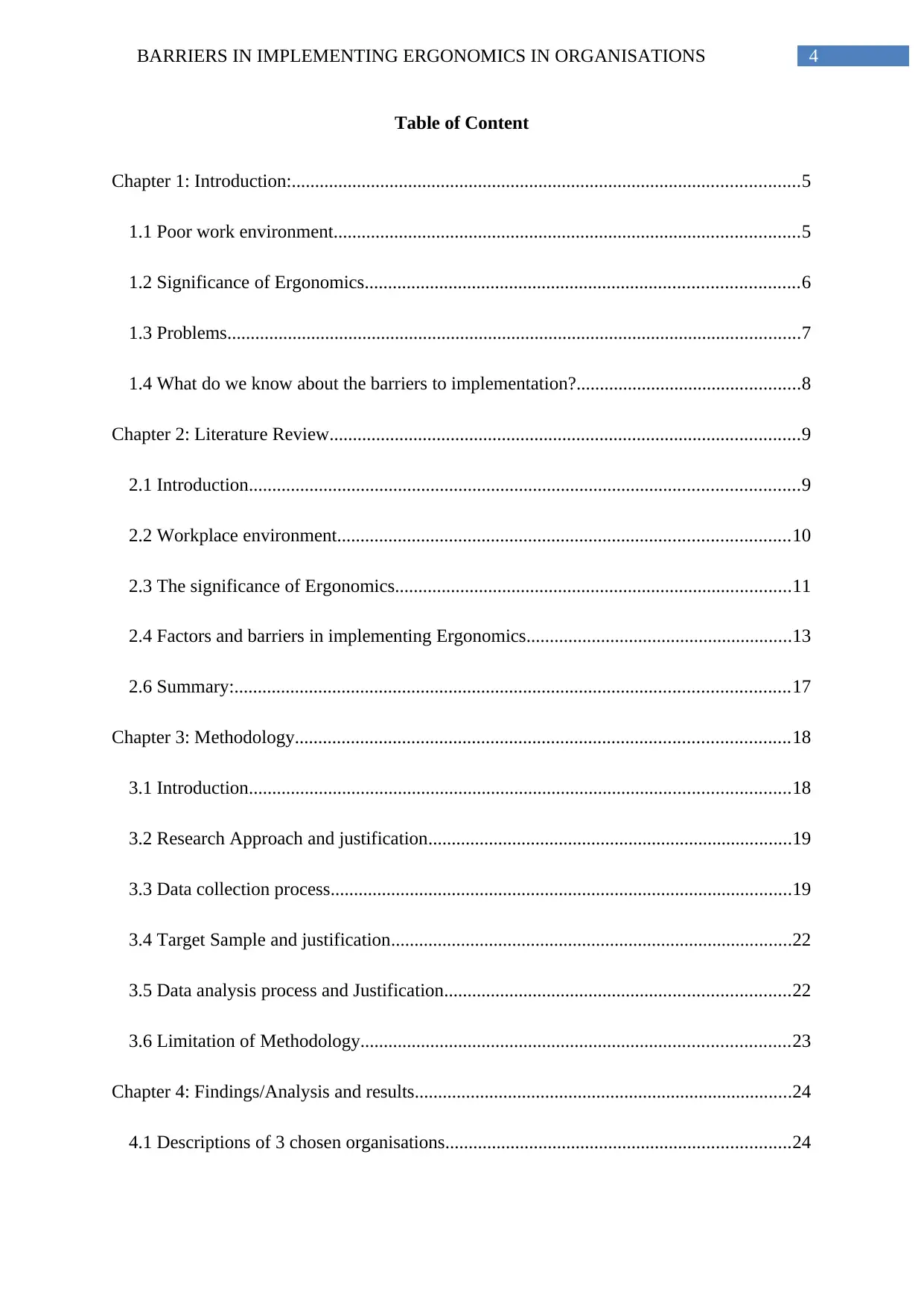
4BARRIERS IN IMPLEMENTING ERGONOMICS IN ORGANISATIONS
Table of Content
Chapter 1: Introduction:.............................................................................................................5
1.1 Poor work environment....................................................................................................5
1.2 Significance of Ergonomics.............................................................................................6
1.3 Problems...........................................................................................................................7
1.4 What do we know about the barriers to implementation?................................................8
Chapter 2: Literature Review.....................................................................................................9
2.1 Introduction......................................................................................................................9
2.2 Workplace environment.................................................................................................10
2.3 The significance of Ergonomics.....................................................................................11
2.4 Factors and barriers in implementing Ergonomics.........................................................13
2.6 Summary:.......................................................................................................................17
Chapter 3: Methodology..........................................................................................................18
3.1 Introduction....................................................................................................................18
3.2 Research Approach and justification..............................................................................19
3.3 Data collection process...................................................................................................19
3.4 Target Sample and justification......................................................................................22
3.5 Data analysis process and Justification..........................................................................22
3.6 Limitation of Methodology............................................................................................23
Chapter 4: Findings/Analysis and results.................................................................................24
4.1 Descriptions of 3 chosen organisations..........................................................................24
Table of Content
Chapter 1: Introduction:.............................................................................................................5
1.1 Poor work environment....................................................................................................5
1.2 Significance of Ergonomics.............................................................................................6
1.3 Problems...........................................................................................................................7
1.4 What do we know about the barriers to implementation?................................................8
Chapter 2: Literature Review.....................................................................................................9
2.1 Introduction......................................................................................................................9
2.2 Workplace environment.................................................................................................10
2.3 The significance of Ergonomics.....................................................................................11
2.4 Factors and barriers in implementing Ergonomics.........................................................13
2.6 Summary:.......................................................................................................................17
Chapter 3: Methodology..........................................................................................................18
3.1 Introduction....................................................................................................................18
3.2 Research Approach and justification..............................................................................19
3.3 Data collection process...................................................................................................19
3.4 Target Sample and justification......................................................................................22
3.5 Data analysis process and Justification..........................................................................22
3.6 Limitation of Methodology............................................................................................23
Chapter 4: Findings/Analysis and results.................................................................................24
4.1 Descriptions of 3 chosen organisations..........................................................................24

5BARRIERS IN IMPLEMENTING ERGONOMICS IN ORGANISATIONS
4.2 Thematic data analysis of interview responses..............................................................25
Chapter 6: Conclusion..............................................................................................................34
References:...............................................................................................................................38
4.2 Thematic data analysis of interview responses..............................................................25
Chapter 6: Conclusion..............................................................................................................34
References:...............................................................................................................................38
⊘ This is a preview!⊘
Do you want full access?
Subscribe today to unlock all pages.

Trusted by 1+ million students worldwide
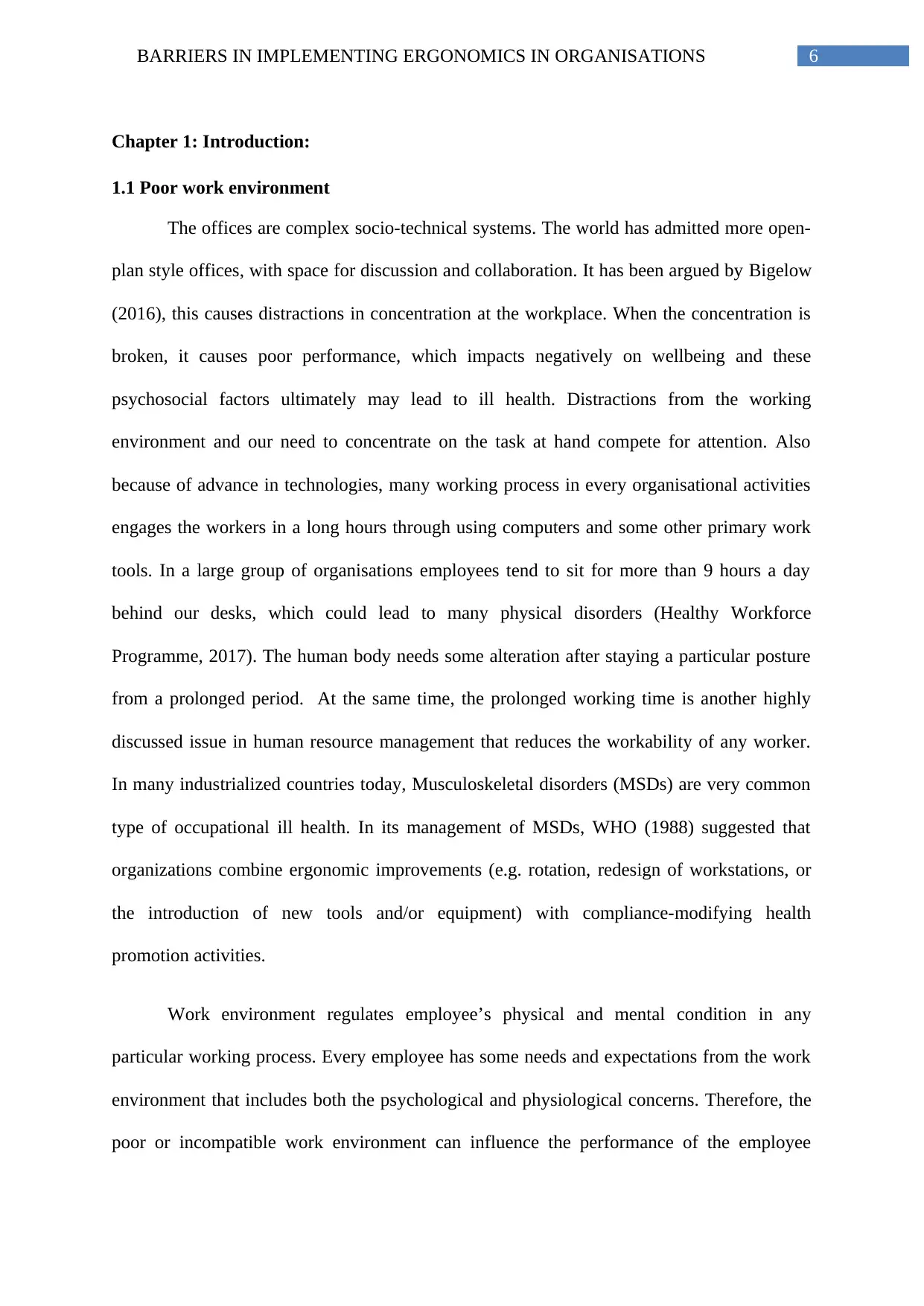
6BARRIERS IN IMPLEMENTING ERGONOMICS IN ORGANISATIONS
Chapter 1: Introduction:
1.1 Poor work environment
The offices are complex socio-technical systems. The world has admitted more open-
plan style offices, with space for discussion and collaboration. It has been argued by Bigelow
(2016), this causes distractions in concentration at the workplace. When the concentration is
broken, it causes poor performance, which impacts negatively on wellbeing and these
psychosocial factors ultimately may lead to ill health. Distractions from the working
environment and our need to concentrate on the task at hand compete for attention. Also
because of advance in technologies, many working process in every organisational activities
engages the workers in a long hours through using computers and some other primary work
tools. In a large group of organisations employees tend to sit for more than 9 hours a day
behind our desks, which could lead to many physical disorders (Healthy Workforce
Programme, 2017). The human body needs some alteration after staying a particular posture
from a prolonged period. At the same time, the prolonged working time is another highly
discussed issue in human resource management that reduces the workability of any worker.
In many industrialized countries today, Musculoskeletal disorders (MSDs) are very common
type of occupational ill health. In its management of MSDs, WHO (1988) suggested that
organizations combine ergonomic improvements (e.g. rotation, redesign of workstations, or
the introduction of new tools and/or equipment) with compliance-modifying health
promotion activities.
Work environment regulates employee’s physical and mental condition in any
particular working process. Every employee has some needs and expectations from the work
environment that includes both the psychological and physiological concerns. Therefore, the
poor or incompatible work environment can influence the performance of the employee
Chapter 1: Introduction:
1.1 Poor work environment
The offices are complex socio-technical systems. The world has admitted more open-
plan style offices, with space for discussion and collaboration. It has been argued by Bigelow
(2016), this causes distractions in concentration at the workplace. When the concentration is
broken, it causes poor performance, which impacts negatively on wellbeing and these
psychosocial factors ultimately may lead to ill health. Distractions from the working
environment and our need to concentrate on the task at hand compete for attention. Also
because of advance in technologies, many working process in every organisational activities
engages the workers in a long hours through using computers and some other primary work
tools. In a large group of organisations employees tend to sit for more than 9 hours a day
behind our desks, which could lead to many physical disorders (Healthy Workforce
Programme, 2017). The human body needs some alteration after staying a particular posture
from a prolonged period. At the same time, the prolonged working time is another highly
discussed issue in human resource management that reduces the workability of any worker.
In many industrialized countries today, Musculoskeletal disorders (MSDs) are very common
type of occupational ill health. In its management of MSDs, WHO (1988) suggested that
organizations combine ergonomic improvements (e.g. rotation, redesign of workstations, or
the introduction of new tools and/or equipment) with compliance-modifying health
promotion activities.
Work environment regulates employee’s physical and mental condition in any
particular working process. Every employee has some needs and expectations from the work
environment that includes both the psychological and physiological concerns. Therefore, the
poor or incompatible work environment can influence the performance of the employee
Paraphrase This Document
Need a fresh take? Get an instant paraphrase of this document with our AI Paraphraser
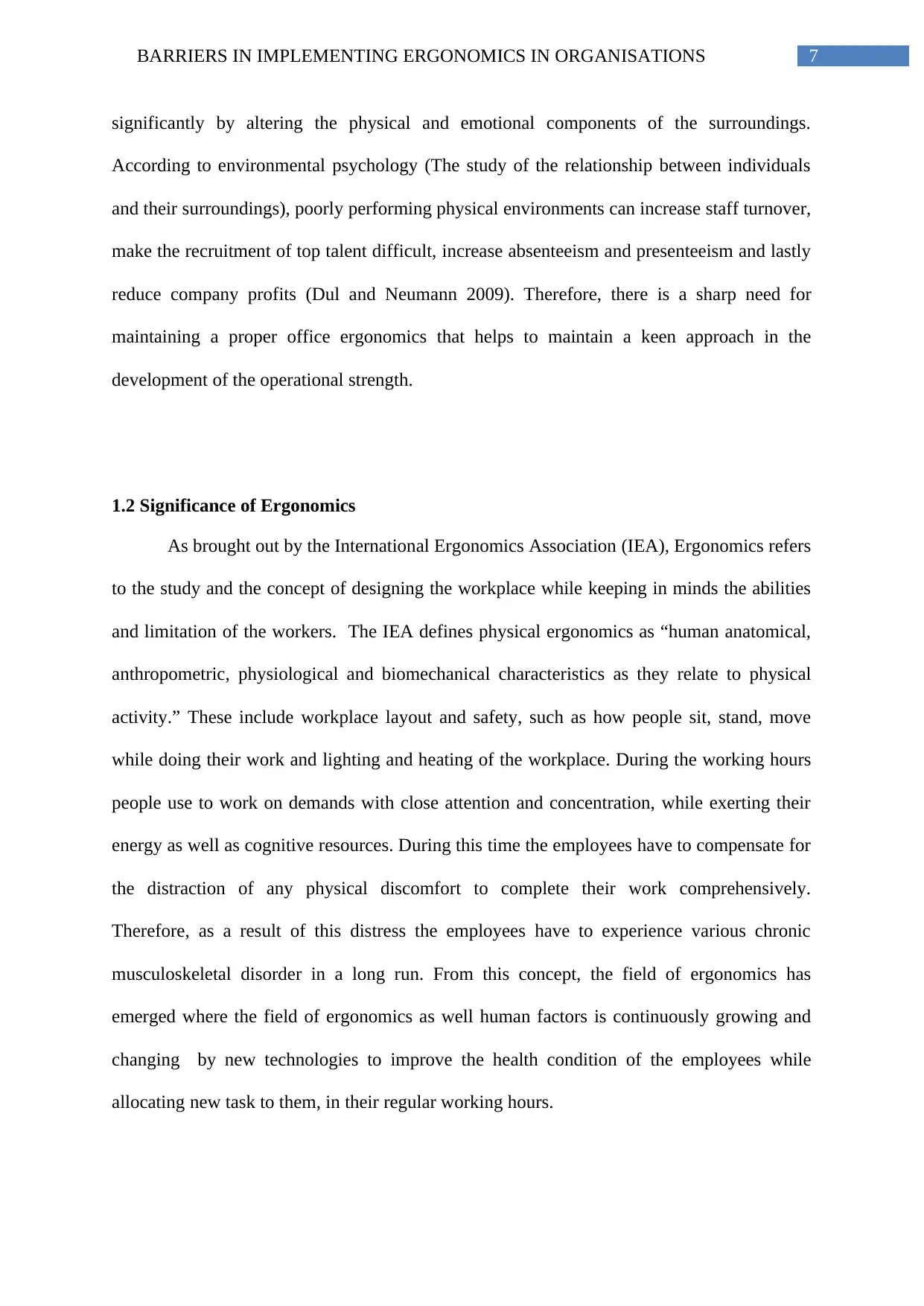
7BARRIERS IN IMPLEMENTING ERGONOMICS IN ORGANISATIONS
significantly by altering the physical and emotional components of the surroundings.
According to environmental psychology (The study of the relationship between individuals
and their surroundings), poorly performing physical environments can increase staff turnover,
make the recruitment of top talent difficult, increase absenteeism and presenteeism and lastly
reduce company profits (Dul and Neumann 2009). Therefore, there is a sharp need for
maintaining a proper office ergonomics that helps to maintain a keen approach in the
development of the operational strength.
1.2 Significance of Ergonomics
As brought out by the International Ergonomics Association (IEA), Ergonomics refers
to the study and the concept of designing the workplace while keeping in minds the abilities
and limitation of the workers. The IEA defines physical ergonomics as “human anatomical,
anthropometric, physiological and biomechanical characteristics as they relate to physical
activity.” These include workplace layout and safety, such as how people sit, stand, move
while doing their work and lighting and heating of the workplace. During the working hours
people use to work on demands with close attention and concentration, while exerting their
energy as well as cognitive resources. During this time the employees have to compensate for
the distraction of any physical discomfort to complete their work comprehensively.
Therefore, as a result of this distress the employees have to experience various chronic
musculoskeletal disorder in a long run. From this concept, the field of ergonomics has
emerged where the field of ergonomics as well human factors is continuously growing and
changing by new technologies to improve the health condition of the employees while
allocating new task to them, in their regular working hours.
significantly by altering the physical and emotional components of the surroundings.
According to environmental psychology (The study of the relationship between individuals
and their surroundings), poorly performing physical environments can increase staff turnover,
make the recruitment of top talent difficult, increase absenteeism and presenteeism and lastly
reduce company profits (Dul and Neumann 2009). Therefore, there is a sharp need for
maintaining a proper office ergonomics that helps to maintain a keen approach in the
development of the operational strength.
1.2 Significance of Ergonomics
As brought out by the International Ergonomics Association (IEA), Ergonomics refers
to the study and the concept of designing the workplace while keeping in minds the abilities
and limitation of the workers. The IEA defines physical ergonomics as “human anatomical,
anthropometric, physiological and biomechanical characteristics as they relate to physical
activity.” These include workplace layout and safety, such as how people sit, stand, move
while doing their work and lighting and heating of the workplace. During the working hours
people use to work on demands with close attention and concentration, while exerting their
energy as well as cognitive resources. During this time the employees have to compensate for
the distraction of any physical discomfort to complete their work comprehensively.
Therefore, as a result of this distress the employees have to experience various chronic
musculoskeletal disorder in a long run. From this concept, the field of ergonomics has
emerged where the field of ergonomics as well human factors is continuously growing and
changing by new technologies to improve the health condition of the employees while
allocating new task to them, in their regular working hours.
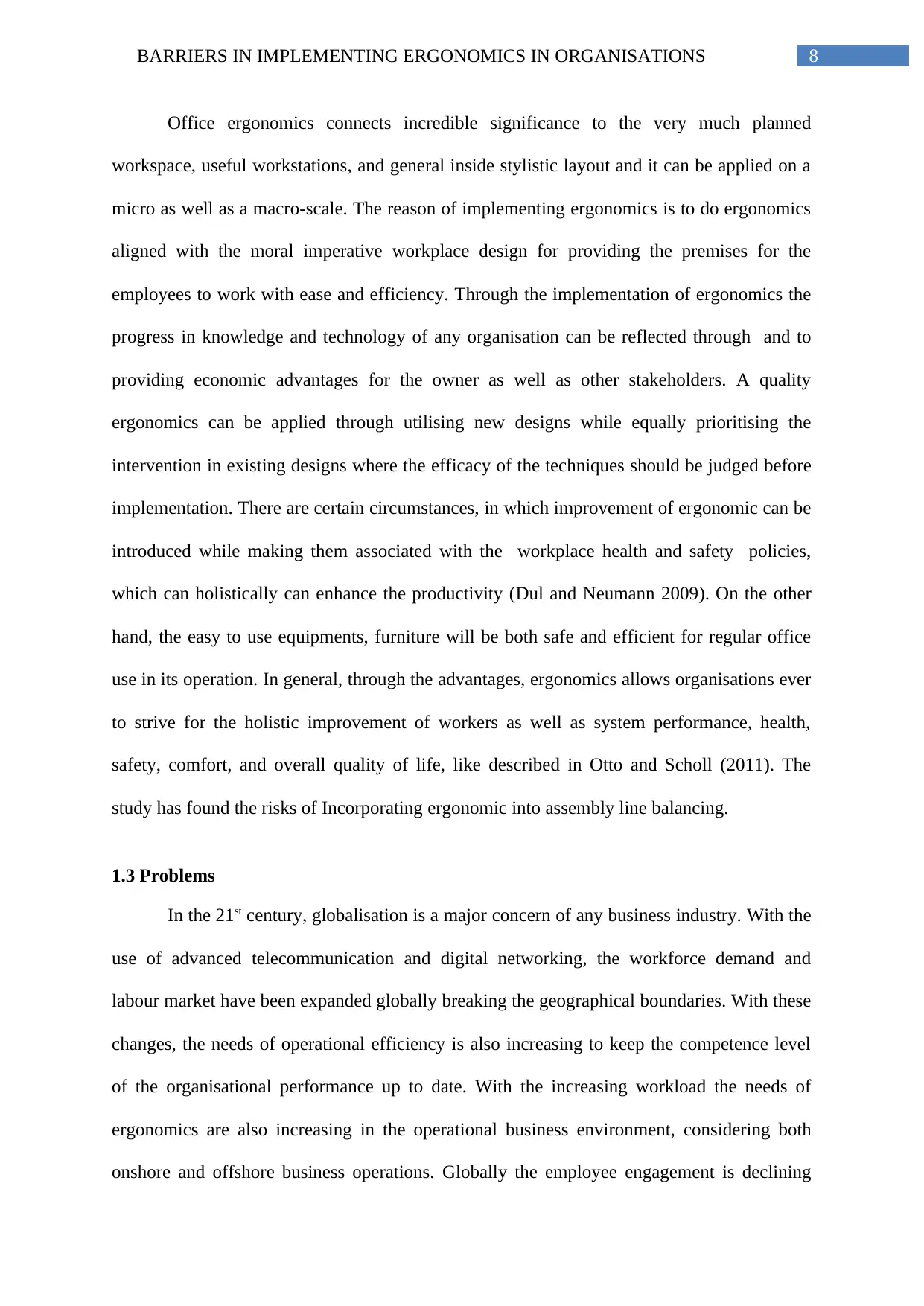
8BARRIERS IN IMPLEMENTING ERGONOMICS IN ORGANISATIONS
Office ergonomics connects incredible significance to the very much planned
workspace, useful workstations, and general inside stylistic layout and it can be applied on a
micro as well as a macro-scale. The reason of implementing ergonomics is to do ergonomics
aligned with the moral imperative workplace design for providing the premises for the
employees to work with ease and efficiency. Through the implementation of ergonomics the
progress in knowledge and technology of any organisation can be reflected through and to
providing economic advantages for the owner as well as other stakeholders. A quality
ergonomics can be applied through utilising new designs while equally prioritising the
intervention in existing designs where the efficacy of the techniques should be judged before
implementation. There are certain circumstances, in which improvement of ergonomic can be
introduced while making them associated with the workplace health and safety policies,
which can holistically can enhance the productivity (Dul and Neumann 2009). On the other
hand, the easy to use equipments, furniture will be both safe and efficient for regular office
use in its operation. In general, through the advantages, ergonomics allows organisations ever
to strive for the holistic improvement of workers as well as system performance, health,
safety, comfort, and overall quality of life, like described in Otto and Scholl (2011). The
study has found the risks of Incorporating ergonomic into assembly line balancing.
1.3 Problems
In the 21st century, globalisation is a major concern of any business industry. With the
use of advanced telecommunication and digital networking, the workforce demand and
labour market have been expanded globally breaking the geographical boundaries. With these
changes, the needs of operational efficiency is also increasing to keep the competence level
of the organisational performance up to date. With the increasing workload the needs of
ergonomics are also increasing in the operational business environment, considering both
onshore and offshore business operations. Globally the employee engagement is declining
Office ergonomics connects incredible significance to the very much planned
workspace, useful workstations, and general inside stylistic layout and it can be applied on a
micro as well as a macro-scale. The reason of implementing ergonomics is to do ergonomics
aligned with the moral imperative workplace design for providing the premises for the
employees to work with ease and efficiency. Through the implementation of ergonomics the
progress in knowledge and technology of any organisation can be reflected through and to
providing economic advantages for the owner as well as other stakeholders. A quality
ergonomics can be applied through utilising new designs while equally prioritising the
intervention in existing designs where the efficacy of the techniques should be judged before
implementation. There are certain circumstances, in which improvement of ergonomic can be
introduced while making them associated with the workplace health and safety policies,
which can holistically can enhance the productivity (Dul and Neumann 2009). On the other
hand, the easy to use equipments, furniture will be both safe and efficient for regular office
use in its operation. In general, through the advantages, ergonomics allows organisations ever
to strive for the holistic improvement of workers as well as system performance, health,
safety, comfort, and overall quality of life, like described in Otto and Scholl (2011). The
study has found the risks of Incorporating ergonomic into assembly line balancing.
1.3 Problems
In the 21st century, globalisation is a major concern of any business industry. With the
use of advanced telecommunication and digital networking, the workforce demand and
labour market have been expanded globally breaking the geographical boundaries. With these
changes, the needs of operational efficiency is also increasing to keep the competence level
of the organisational performance up to date. With the increasing workload the needs of
ergonomics are also increasing in the operational business environment, considering both
onshore and offshore business operations. Globally the employee engagement is declining
⊘ This is a preview!⊘
Do you want full access?
Subscribe today to unlock all pages.

Trusted by 1+ million students worldwide
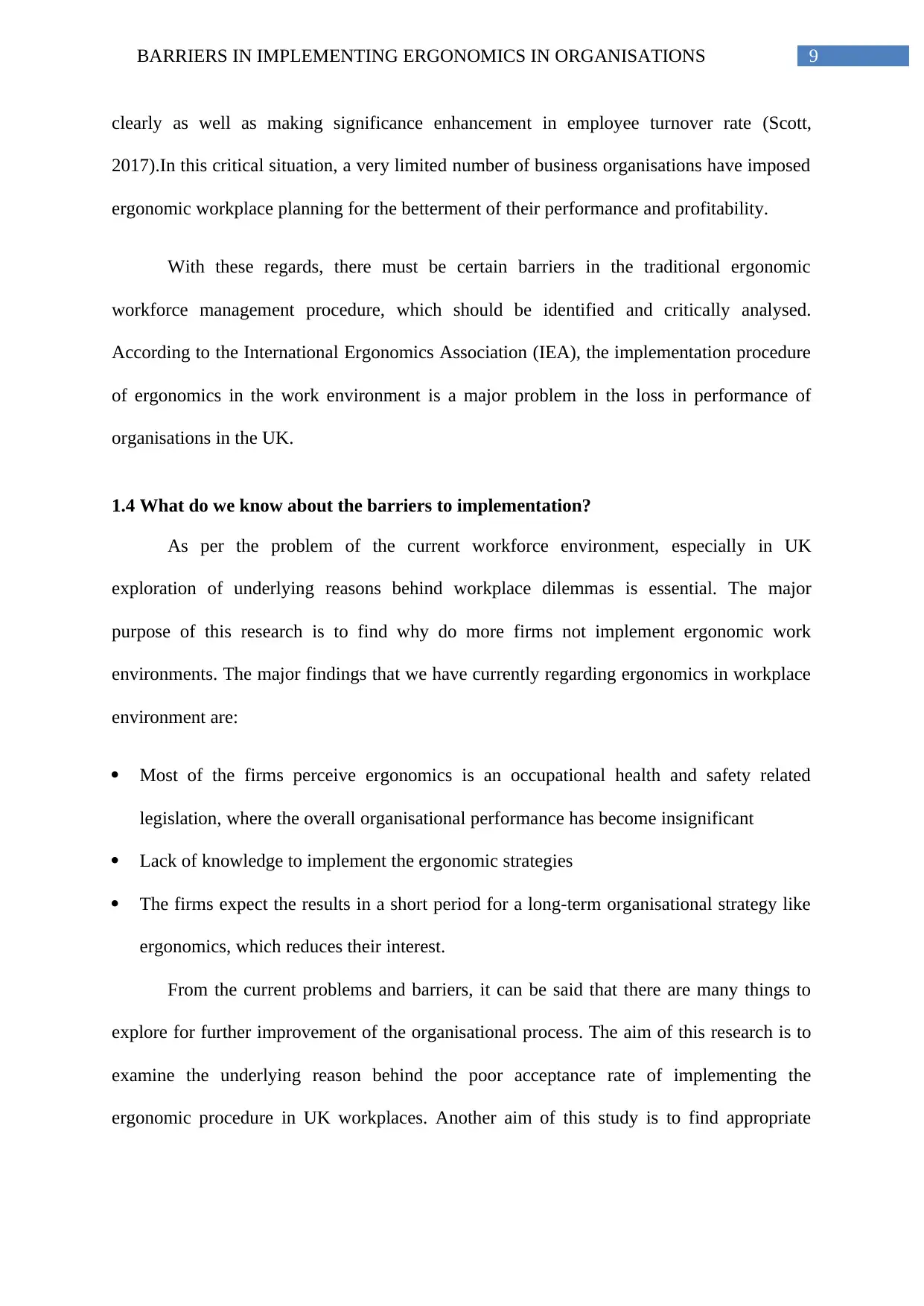
9BARRIERS IN IMPLEMENTING ERGONOMICS IN ORGANISATIONS
clearly as well as making significance enhancement in employee turnover rate (Scott,
2017).In this critical situation, a very limited number of business organisations have imposed
ergonomic workplace planning for the betterment of their performance and profitability.
With these regards, there must be certain barriers in the traditional ergonomic
workforce management procedure, which should be identified and critically analysed.
According to the International Ergonomics Association (IEA), the implementation procedure
of ergonomics in the work environment is a major problem in the loss in performance of
organisations in the UK.
1.4 What do we know about the barriers to implementation?
As per the problem of the current workforce environment, especially in UK
exploration of underlying reasons behind workplace dilemmas is essential. The major
purpose of this research is to find why do more firms not implement ergonomic work
environments. The major findings that we have currently regarding ergonomics in workplace
environment are:
Most of the firms perceive ergonomics is an occupational health and safety related
legislation, where the overall organisational performance has become insignificant
Lack of knowledge to implement the ergonomic strategies
The firms expect the results in a short period for a long-term organisational strategy like
ergonomics, which reduces their interest.
From the current problems and barriers, it can be said that there are many things to
explore for further improvement of the organisational process. The aim of this research is to
examine the underlying reason behind the poor acceptance rate of implementing the
ergonomic procedure in UK workplaces. Another aim of this study is to find appropriate
clearly as well as making significance enhancement in employee turnover rate (Scott,
2017).In this critical situation, a very limited number of business organisations have imposed
ergonomic workplace planning for the betterment of their performance and profitability.
With these regards, there must be certain barriers in the traditional ergonomic
workforce management procedure, which should be identified and critically analysed.
According to the International Ergonomics Association (IEA), the implementation procedure
of ergonomics in the work environment is a major problem in the loss in performance of
organisations in the UK.
1.4 What do we know about the barriers to implementation?
As per the problem of the current workforce environment, especially in UK
exploration of underlying reasons behind workplace dilemmas is essential. The major
purpose of this research is to find why do more firms not implement ergonomic work
environments. The major findings that we have currently regarding ergonomics in workplace
environment are:
Most of the firms perceive ergonomics is an occupational health and safety related
legislation, where the overall organisational performance has become insignificant
Lack of knowledge to implement the ergonomic strategies
The firms expect the results in a short period for a long-term organisational strategy like
ergonomics, which reduces their interest.
From the current problems and barriers, it can be said that there are many things to
explore for further improvement of the organisational process. The aim of this research is to
examine the underlying reason behind the poor acceptance rate of implementing the
ergonomic procedure in UK workplaces. Another aim of this study is to find appropriate
Paraphrase This Document
Need a fresh take? Get an instant paraphrase of this document with our AI Paraphraser
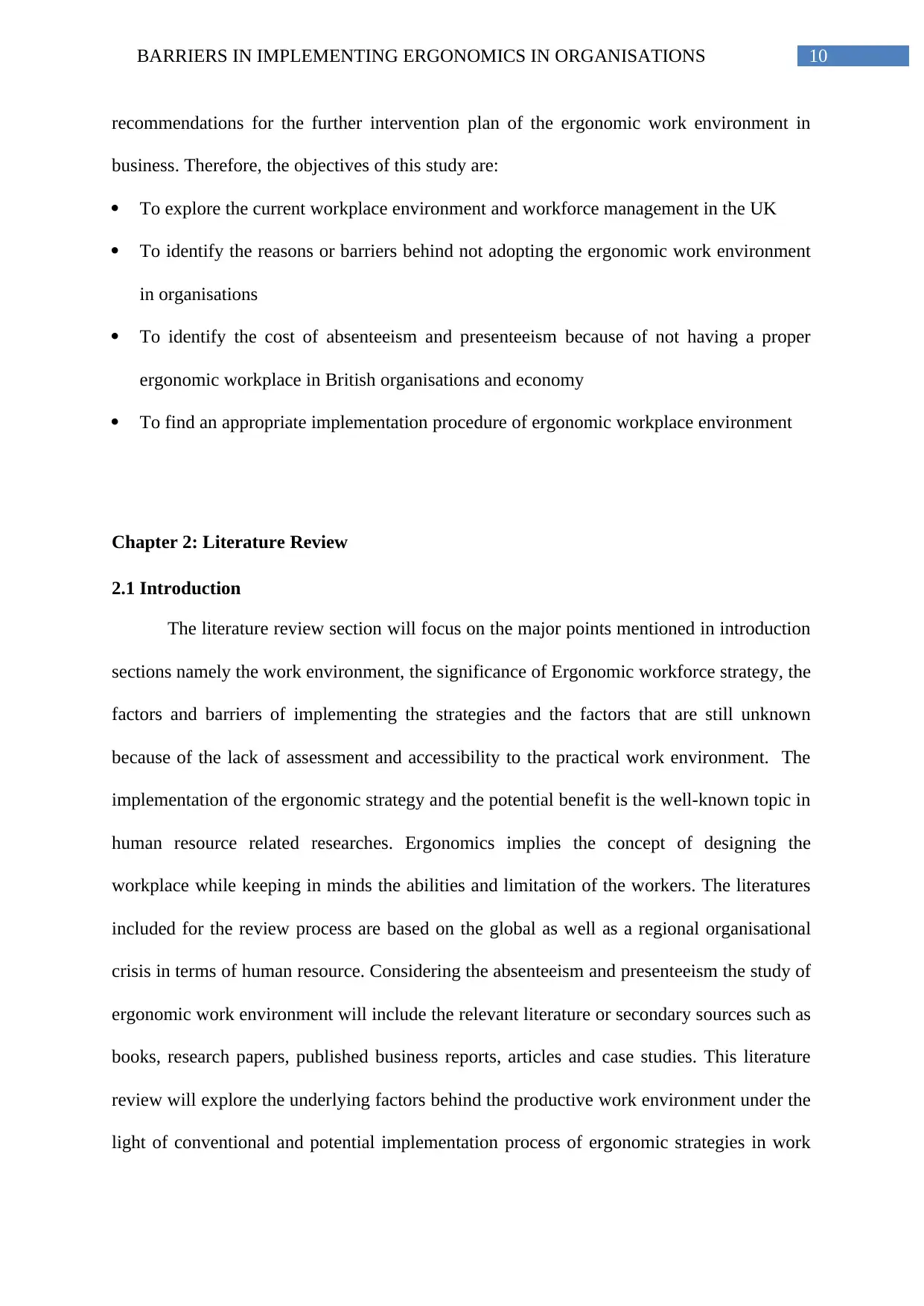
10BARRIERS IN IMPLEMENTING ERGONOMICS IN ORGANISATIONS
recommendations for the further intervention plan of the ergonomic work environment in
business. Therefore, the objectives of this study are:
To explore the current workplace environment and workforce management in the UK
To identify the reasons or barriers behind not adopting the ergonomic work environment
in organisations
To identify the cost of absenteeism and presenteeism because of not having a proper
ergonomic workplace in British organisations and economy
To find an appropriate implementation procedure of ergonomic workplace environment
Chapter 2: Literature Review
2.1 Introduction
The literature review section will focus on the major points mentioned in introduction
sections namely the work environment, the significance of Ergonomic workforce strategy, the
factors and barriers of implementing the strategies and the factors that are still unknown
because of the lack of assessment and accessibility to the practical work environment. The
implementation of the ergonomic strategy and the potential benefit is the well-known topic in
human resource related researches. Ergonomics implies the concept of designing the
workplace while keeping in minds the abilities and limitation of the workers. The literatures
included for the review process are based on the global as well as a regional organisational
crisis in terms of human resource. Considering the absenteeism and presenteeism the study of
ergonomic work environment will include the relevant literature or secondary sources such as
books, research papers, published business reports, articles and case studies. This literature
review will explore the underlying factors behind the productive work environment under the
light of conventional and potential implementation process of ergonomic strategies in work
recommendations for the further intervention plan of the ergonomic work environment in
business. Therefore, the objectives of this study are:
To explore the current workplace environment and workforce management in the UK
To identify the reasons or barriers behind not adopting the ergonomic work environment
in organisations
To identify the cost of absenteeism and presenteeism because of not having a proper
ergonomic workplace in British organisations and economy
To find an appropriate implementation procedure of ergonomic workplace environment
Chapter 2: Literature Review
2.1 Introduction
The literature review section will focus on the major points mentioned in introduction
sections namely the work environment, the significance of Ergonomic workforce strategy, the
factors and barriers of implementing the strategies and the factors that are still unknown
because of the lack of assessment and accessibility to the practical work environment. The
implementation of the ergonomic strategy and the potential benefit is the well-known topic in
human resource related researches. Ergonomics implies the concept of designing the
workplace while keeping in minds the abilities and limitation of the workers. The literatures
included for the review process are based on the global as well as a regional organisational
crisis in terms of human resource. Considering the absenteeism and presenteeism the study of
ergonomic work environment will include the relevant literature or secondary sources such as
books, research papers, published business reports, articles and case studies. This literature
review will explore the underlying factors behind the productive work environment under the
light of conventional and potential implementation process of ergonomic strategies in work
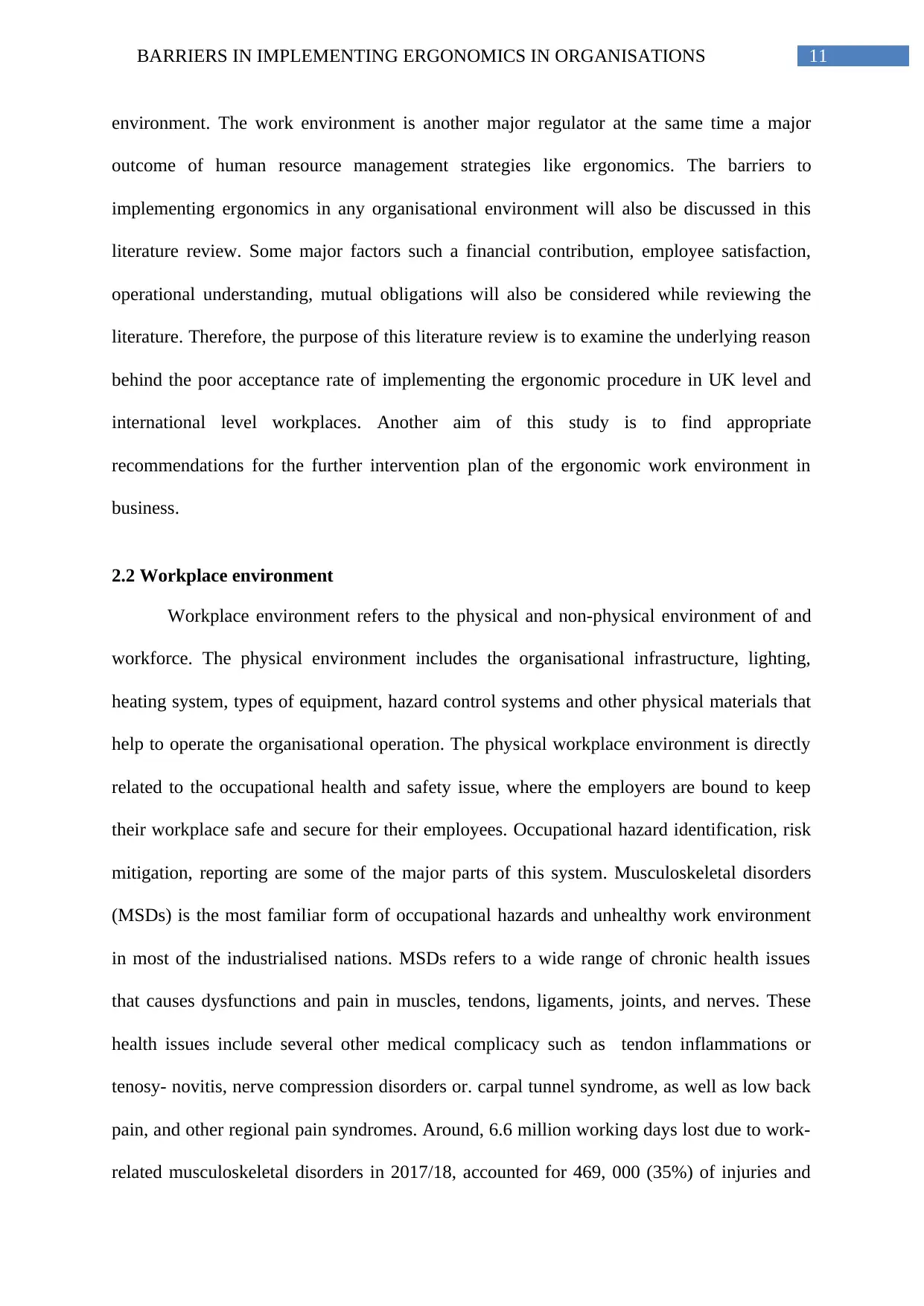
11BARRIERS IN IMPLEMENTING ERGONOMICS IN ORGANISATIONS
environment. The work environment is another major regulator at the same time a major
outcome of human resource management strategies like ergonomics. The barriers to
implementing ergonomics in any organisational environment will also be discussed in this
literature review. Some major factors such a financial contribution, employee satisfaction,
operational understanding, mutual obligations will also be considered while reviewing the
literature. Therefore, the purpose of this literature review is to examine the underlying reason
behind the poor acceptance rate of implementing the ergonomic procedure in UK level and
international level workplaces. Another aim of this study is to find appropriate
recommendations for the further intervention plan of the ergonomic work environment in
business.
2.2 Workplace environment
Workplace environment refers to the physical and non-physical environment of and
workforce. The physical environment includes the organisational infrastructure, lighting,
heating system, types of equipment, hazard control systems and other physical materials that
help to operate the organisational operation. The physical workplace environment is directly
related to the occupational health and safety issue, where the employers are bound to keep
their workplace safe and secure for their employees. Occupational hazard identification, risk
mitigation, reporting are some of the major parts of this system. Musculoskeletal disorders
(MSDs) is the most familiar form of occupational hazards and unhealthy work environment
in most of the industrialised nations. MSDs refers to a wide range of chronic health issues
that causes dysfunctions and pain in muscles, tendons, ligaments, joints, and nerves. These
health issues include several other medical complicacy such as tendon inflammations or
tenosy- novitis, nerve compression disorders or. carpal tunnel syndrome, as well as low back
pain, and other regional pain syndromes. Around, 6.6 million working days lost due to work-
related musculoskeletal disorders in 2017/18, accounted for 469, 000 (35%) of injuries and
environment. The work environment is another major regulator at the same time a major
outcome of human resource management strategies like ergonomics. The barriers to
implementing ergonomics in any organisational environment will also be discussed in this
literature review. Some major factors such a financial contribution, employee satisfaction,
operational understanding, mutual obligations will also be considered while reviewing the
literature. Therefore, the purpose of this literature review is to examine the underlying reason
behind the poor acceptance rate of implementing the ergonomic procedure in UK level and
international level workplaces. Another aim of this study is to find appropriate
recommendations for the further intervention plan of the ergonomic work environment in
business.
2.2 Workplace environment
Workplace environment refers to the physical and non-physical environment of and
workforce. The physical environment includes the organisational infrastructure, lighting,
heating system, types of equipment, hazard control systems and other physical materials that
help to operate the organisational operation. The physical workplace environment is directly
related to the occupational health and safety issue, where the employers are bound to keep
their workplace safe and secure for their employees. Occupational hazard identification, risk
mitigation, reporting are some of the major parts of this system. Musculoskeletal disorders
(MSDs) is the most familiar form of occupational hazards and unhealthy work environment
in most of the industrialised nations. MSDs refers to a wide range of chronic health issues
that causes dysfunctions and pain in muscles, tendons, ligaments, joints, and nerves. These
health issues include several other medical complicacy such as tendon inflammations or
tenosy- novitis, nerve compression disorders or. carpal tunnel syndrome, as well as low back
pain, and other regional pain syndromes. Around, 6.6 million working days lost due to work-
related musculoskeletal disorders in 2017/18, accounted for 469, 000 (35%) of injuries and
⊘ This is a preview!⊘
Do you want full access?
Subscribe today to unlock all pages.

Trusted by 1+ million students worldwide
1 out of 45
Related Documents
Your All-in-One AI-Powered Toolkit for Academic Success.
+13062052269
info@desklib.com
Available 24*7 on WhatsApp / Email
![[object Object]](/_next/static/media/star-bottom.7253800d.svg)
Unlock your academic potential
Copyright © 2020–2025 A2Z Services. All Rights Reserved. Developed and managed by ZUCOL.





